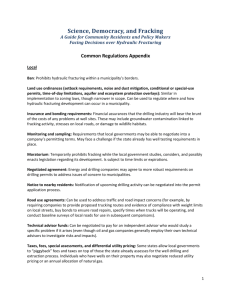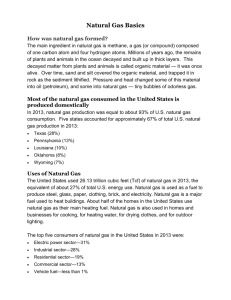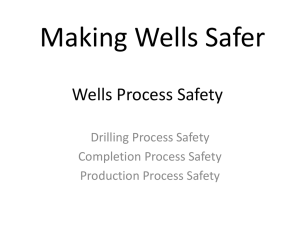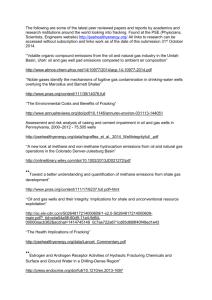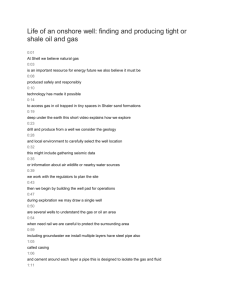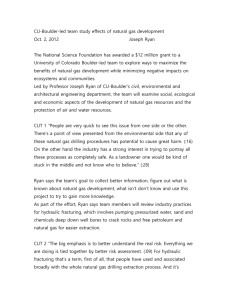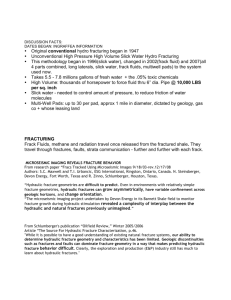DOC - Santa Barbara County Planning and Development
advertisement
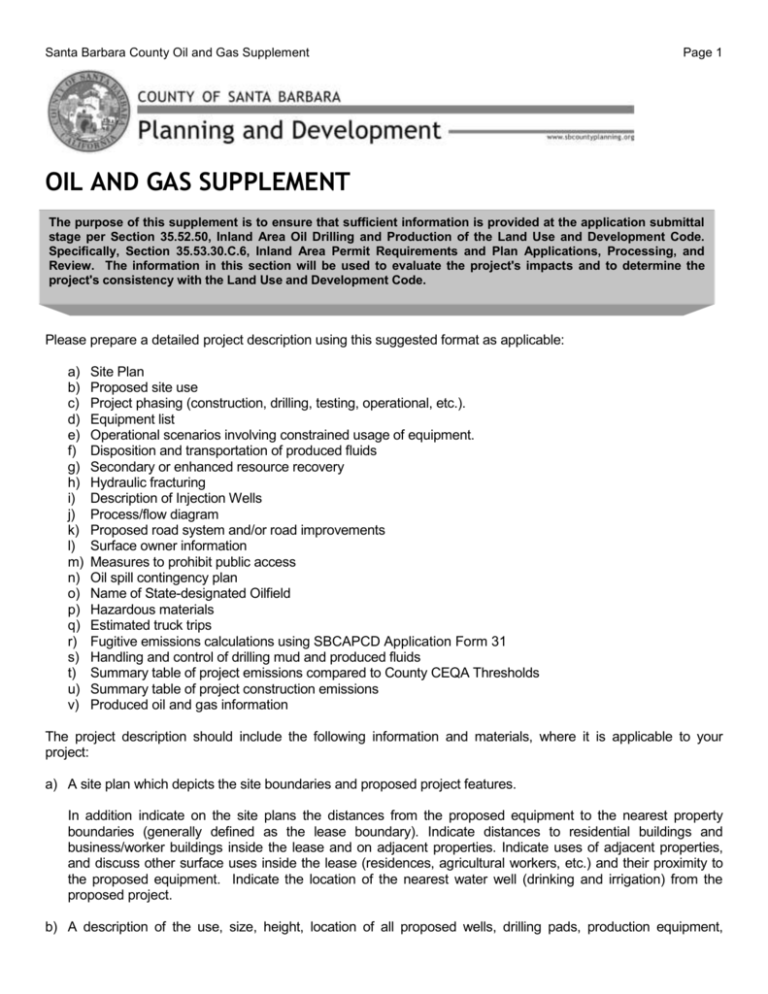
Santa Barbara County Oil and Gas Supplement Page 1 OIL AND GAS SUPPLEMENT The purpose of this supplement is to ensure that sufficient information is provided at the application submittal stage per Section 35.52.50, Inland Area Oil Drilling and Production of the Land Use and Development Code. Specifically, Section 35.53.30.C.6, Inland Area Permit Requirements and Plan Applications, Processing, and Review. The information in this section will be used to evaluate the project's impacts and to determine the project's consistency with the Land Use and Development Code. Please prepare a detailed project description using this suggested format as applicable: a) b) c) d) e) f) g) h) i) j) k) l) m) n) o) p) q) r) s) t) u) v) Site Plan Proposed site use Project phasing (construction, drilling, testing, operational, etc.). Equipment list Operational scenarios involving constrained usage of equipment. Disposition and transportation of produced fluids Secondary or enhanced resource recovery Hydraulic fracturing Description of Injection Wells Process/flow diagram Proposed road system and/or road improvements Surface owner information Measures to prohibit public access Oil spill contingency plan Name of State-designated Oilfield Hazardous materials Estimated truck trips Fugitive emissions calculations using SBCAPCD Application Form 31 Handling and control of drilling mud and produced fluids Summary table of project emissions compared to County CEQA Thresholds Summary table of project construction emissions Produced oil and gas information The project description should include the following information and materials, where it is applicable to your project: a) A site plan which depicts the site boundaries and proposed project features. In addition indicate on the site plans the distances from the proposed equipment to the nearest property boundaries (generally defined as the lease boundary). Indicate distances to residential buildings and business/worker buildings inside the lease and on adjacent properties. Indicate uses of adjacent properties, and discuss other surface uses inside the lease (residences, agricultural workers, etc.) and their proximity to the proposed equipment. Indicate the location of the nearest water well (drinking and irrigation) from the proposed project. b) A description of the use, size, height, location of all proposed wells, drilling pads, production equipment, Santa Barbara County Oil and Gas Supplement Page 2 pipelines, processing equipment, ancillary structures, and limits of work areas for all phases of the project. A description of the target depth and geologic formation of proposed wells. c) A description and schedule for all phases of the project (construction, drilling, testing, operation, etc.), including an estimate of how long the drilling rig will be located on-site (including assembly, disassembly and removal) and how long the drilling program will take. Describe any subsequent phases envisioned upon completion of the wells, such as reworking wells, acidizing wells, etc. For well completion methods involving pressure above ambient pressure, provide the fracture pressure of the reservoir/rock and the pressure of the well completion method. d) A list of project equipment, a description of how all equipment will be powered (i.e., via grid electricity or via internal combustion engine), and a description of whether drilling rigs will be registered with the California Air Resources Board’s Portable Equipment Registration Program. e) If the usage of any project equipment is proposed to be limited below maximum capacity, please describe in detail the method by which the equipment usage will be constrained and monitored (for example fuel metering or data logging). f) A description of the disposition of oil, natural gas, natural gas liquids, and produced water extracted from the well(s), including mode and route of transportation. g) A description of any secondary and enhanced recovery method (anything that enhances natural flow of production) proposed as part of this project. Identify what means you are employing; all fluids to be used as part of the secondary and enhanced recovery method; the source of the water. For secondary and enhanced recovery methods involving pressure above ambient pressure, provide the fracture pressure of the reservoir/rock and the pressure of the secondary or enhanced recovery method. h) A description of any hydraulic fracturing on any new or existing well proposed as part of this project. Identify all fluids to be used, the source of water, upper and lower depth of groundwater where hydraulic fracturing is proposed, the fracture pressure of the reservoir/rock, depth and pressure at which hydraulic fracturing would occur, how often hydraulic fracturing would be employed. All chemicals associated with hydraulic fracturing to be used and how and where they would be stored onsite and how they would be disposed of after fracturing. Submit a copy of the Business Plan. i) A description of any Class II Injection wells proposed. Identify targeted depth and geologic formation, and whether the targeted zone is designated exempt under the DOGGR Underground Injection Control program. If not exempt, provide water quality analysis (total dissolved solids) as required by DOGGR. j) Attach a process flow diagram for the oil production and gas handling equipment at the site (see attached APCD example). Indicate all listed equipment on the flow diagram. Also, list any energy efficiencies incorporated into the project design. k) A description of the proposed road system and/or road improvements that will be necessary to carry out the project. Include information on ingress, egress, road width and surface. l) Provide name and contact information of surface owner(s). Have you informed the surface owner about this application? m) Information on measures proposed to prohibit public access to the site during operations. n) Oil Spill Contingency Plan. o) Name of State Designated Oilfield. p) A list and quantities of any hazardous materials proposed to be stored/discharged/produced or used on the Santa Barbara County Oil and Gas Supplement Page 3 property temporarily or permanently. Describe the proposed use and method of storage and disposal. q) A description of the expected number of truck trips required to implement the proposed project (Peak and Daily Average Trip). Please include trips for: 1) Site Preparation; 2) Drilling; 3) Production; 4) Processing; and 5) Maintenance. Include trips for import of materials (blend oil, water), and export of produced oil. r) The fugitive emissions calculations for both criteria pollutants and greenhouse gases (quantity and type) required to implement the proposed project using SBCAPCD Application Form 31, available at: http://www.ourair.org/wp-content/uploads/APCD-31ver-2.2.pdf. s) A discussion of handling and control of drilling mud/fluids from well drilling and completion, addressing how produced gas will be controlled before the production facilities are constructed or connected to the well. t) A summary table of operational project emissions. Include criteria pollutants and greenhouse gases, totaling the stationary, mobile, and indirect emissions (e.g., electricity usage), and compare them to the County’s CEQA significance thresholds (see attached Example Operational Pollutant Summary Table). If any existing equipment (for example, tanks, pipelines, loading racks, or combustion equipment, either onsite or at other locations) is proposed to be used with the proposed project, include the incremental increase in rates and emissions caused by the project. Provide assumptions and backup calculations for all project emissions. u) A summary table of project construction emissions. Include criteria pollutants and greenhouse gases for: construction fleet (workers), worker trips (e.g. to site and back) construction duration, assumed daily disturbance acreage, paving (if applicable), equipment fleet and associated engine types, construction vendors’ trips and coating emissions (if any). Provide detailed description of assumptions and backup calculations for all emissions. v) Indicate the expected maximum oil and gas production rates, the expected maximum Reid vapor pressure (RVP) for the crude, and provide a basis for these estimates. Provide a representative gas analysis that includes the various components expected in the gas (usually methane, CO2, and hydrogen sulfide in percent or ppm), and the maximum pressure at the well head and maximum pressure in a pipeline. Santa Barbara County Oil and Gas Supplement Page 4 Example Operational Pollutant Summary Emission Source Mobile Sources Greater than 25 lbs/day? Stationary Sources (Combustion Devices, Fugitives, etc.) Indirect GHGs from electricity usage Totals County Significance Criteria Table NOx Criteria Pollutants (lb/day) ROC Yes/No Yes/No 55 lb/day 55 lb/day PM10 80 lb/day GHG (Metric Ton/yr) CO2e Santa Barbara County Oil and Gas Supplement Page 5
